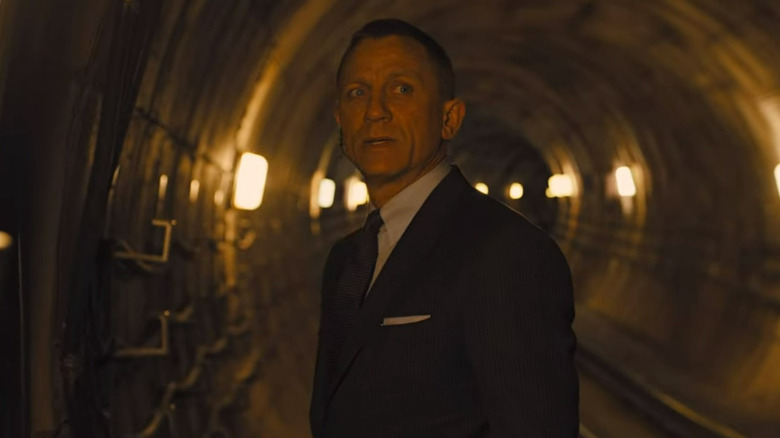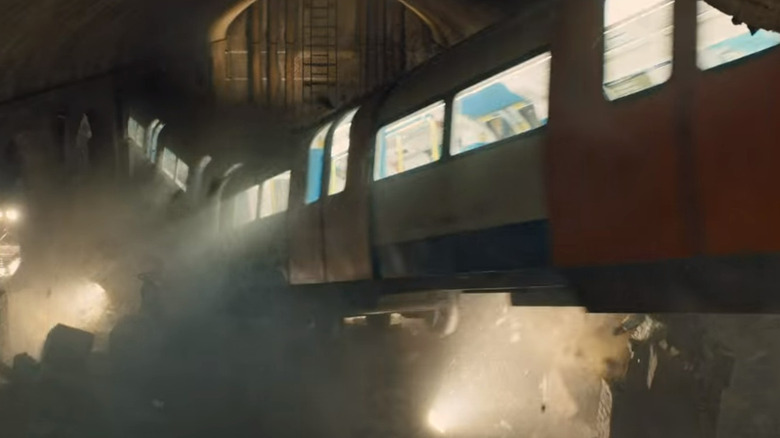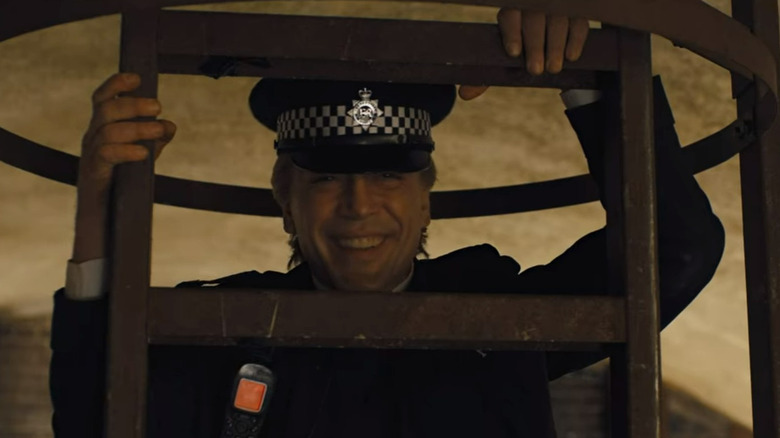The Tube Train Crash In Skyfall Almost Broke The Set
"Skyfall" is the third of five 007 films to star Daniel Craig, a grand total which is exactly four more than what he anticipated receiving. Aside from also being the film that introduced Adele's absolute banger of a Bond theme, it's arguably the best entry into the narrative's modern history. For those who haven't seen it in a while, "Skyfall" sees James Bond (Craig) pitted against Raoul Silva (Javier Bardem), an ex-MI6 agent using his extensive skillset to commit cyberterrorism. Don't misconstrue his preferred criminal activities for occurring entirely behind computer screens, however — this is a Bond film, after all.
In fact, some of Silva's crimes are so physical that one of them even gave the film's crew reason to worry. Don't worry, everyone came out the other end alive and unscathed, and the studio got a lesson in why, sometimes, practical effects aren't always the greatest plan. With that out of the way, let's talk about a (very real) flying train and a (very fake) plywood set!
Cameras, cameras, cameras
In an interview with Total Film, Sam Mendes (the director of "Skyfall") and Roger Deakins (the production's cinematographer) discussed their unified wish to film modern projects with fewer cameras (be patient, this is relevant). Just one, in fact, as doing so prevents potential shot contamination. Mendes defended his position by saying:
"I've always found that when you put a second camera up the danger is that you compromise what the first camera is shooting ... it's a way of working which has a sort of philosophy but is becoming less viable, mostly for commercial reasons. To shoot a Bond movie primarily on one camera — that was quite a tricky balancing act."
Deakins piped in to say that one shot was so tricky that it demanded 11 cameras (Digital Media World reported the official camera count to be at 10 — regardless, it's a lot of cameras). Mendes agreed, saying that, despite his preferred approach, the multi-lens method saved them both a great deal of duress after the subway chase sequence nearly broke the set.
"Yeah, the tube train coming through. It was the only time we did it. At the end of it, there's a judder on the camera. And that is the train hitting the wall of the stage, because it couldn't go any further. We went, 'Christ. Don't fall over!' That was a good experience. It was exhausting for both of us, because to try to make it in a classic style really was hard."
The way Mendes discusses the accident makes it sound like this small, mildly inconvenient thing, rather than the production-halting, set-crushing experience that Digital Media World describes.
A mess for everyone involved
Here's the scene. Just when James Bond thinks he has Raoul Silva cornered in a tunnel system beneath the subway, the villain triggers an explosion that blows a hole in the roof. That hole just so happens to line up perfectly with an oncoming train, which barrels downward, directly towards the space where Bond is standing. Obviously, the hero manages to get out of the way just in time, but the damage is done and Silva successfully gets away. It's a memorable set piece in no small part because the production team felt that it should be done with mostly practical effects at full scale. Or, in other words, "Skyfall" crashed a real train.
Jon Neill (the VFX supervisor for Cinesite, the company in charge of digital touchup for "Skyfall") told Digital Media World that his team ended up doing a lot more legwork on the subway sequence than originally intended because the whole thing broke down. He said:
"[The train was] suspended from brackets to 'fly' into the set, crash through the hole and hit the floor. It [ripped] a big path right across the ceiling. The clean up here was substantial – the path, the brackets and their dust trails all had to be removed ... when the practical set burst apart much of the polystyrene was exposed and had to be disguised as brickwork. Also, as the train advanced toward the built set ... it all began to shudder, behaving like plywood, of course, and not like brickwork. This effect required post stabilization by replacing parts of the sequence with single frames. The explosions were all real, and we added or enhanced the resulting dust and debris."
The funniest part? Neill also had to digitally erase several cameramen.


